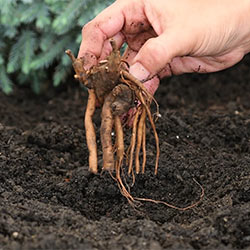Thank You!
We have received your request. You will be notified when this product is in stock.
X
Choosing hostas with variegated or golden green foliage is a great way to lighten a shady spot in the garden. These versatile perennials also make great ground cover. Our hostas for sale are easy to grow and do best when planted in shade or partially shaded areas. Most varieties bloom in the summertime, bringing arching sprays of bell-shaped blooms. The foliage, though, is what most gardeners seek in hostas. Shop now so you can find the perfect hostas plant for sale to brighten up your garden today!
Where do hostas grow best?
Hostas are somewhat impervious plants: they can withstand shady gardens, cold winters, and lots of water. Hostas grow best in shady locations -- they're a joy for gardeners with lots of shade in their yards. Consider planting these beautiful plants near fences or outbuildings, under trees, and as the backdrop to shade gardens. Hostas are also happy to live near decorative ponds and water features.
Hostas grow in zones three to nine, making them a popular plant across the United States. Hostas can flourish in temperate climates, and don't need to be lifted in winter. Hostas actually like locations with lots of snow, as the snow actually insulates the hosta roots against chilly weather, and provides good moisture for spring growth. Even if you don't live in a location with cold winters, there are still varieties of hosta that can grow at your home: not all hostas require a chilling period over the winter. Gardeners in warm zones (over 7) can choose heat-tolerant hostas that have evolved specifically to live in warm areas.
Choose the right location for your hostas. Most varieties can tolerate some early morning sun, but their leaves may burn if faced with hot afternoon sun. Hostas need nutrient-rich soil, so they won't thrive in a location that's heavy in clay or features compacted dirt unless you amend the soil. Hostas don't mind a location heavy in dew -- after all, these are shade plants -- but they do require good drainage.
When to plant hostas:
Hostas are best planted when they will actively grow roots - in early to middle spring or late summer, when the hottest weather has passed. Typically shipped as bare root plants, Hostas can be planted relatively early in the season. Hostas are famously easy to divide and share: if you decide to gift a friend or neighbor with some of these gorgeous foliage plants, you should divide your hostas in the spring. They can be divided and planted later in the year, but will require extra love (and watering) to ensure that your hostas aren't wilted by the hot summer sun.
Do hostas like sun or shade?
Hostas like partial shade: they particularly love sun in the morning and shade in the afternoon, or a dappled shade setting, such as under the foliage of a tree or pergola. Even though they like dappled shade, most hostas can handle the heat of the afternoon sun if provided with adequate water, good drainage, and rich, loamy soil. Typically, hostas can also handle deep shade.
How to plant hostas:
First, choose a perfect location for your hostas. They prefer well-drained, nutrient rich soil, so don't locate them anywhere with too much clay (or, be prepared to amend your clay soil). Nutrient rich soil helps these awesome foliage plants handle the heat. Remember, hostas prefer dappled or partial shade, but can handle some sun, or even deep shade.
Once you've found a spot for your hostas, dig a hole deep enough to set the hostas in so that the crowns (where the stems meet the roots) are level with the existing soil. If you're battling clay soil, backfill the holl with a mixture of soil and compost, manure, or leaf mould. Once they're planted, you should give your hostas a good drink and fertilize them with a balanced, slow-release fertilizer. If you struggle to keep the area around the plants moist, add some mulch around the base of your hostas to retain moisture in the soil —hostas do not appreciate overly dry conditions.
A note about pests: the soft leaves of hostas do make them attractive snacks for deer, rabbits, and, of course, slugs and snails. If you find animal droppings around or chew marks on your plants, try using fencing, a motion-activated sprinkler, or scent-based repellents to shoo away deer and bunnies. If you're finding mysterious holes in your hostas and slime trails around your garden, you likely have slugs or snails. Prevent these pests by using slug bait, beer traps, or diatomaceous earth to keep them away from your hostas!
When to cut back hostas?
Let's talk about cutting back hosta plants. Hosta flowers can be cut back as they fade—cutting back hosta flowers encourages reblooming, and can be achieved by simply clipping the long flower stalks once the flowers have faded. Hosta flowers can be clipped back throughout the growing season.
Fall is the time to cut back the foliage of your hostas - many varieties display fall color, so don't cut your hostas back until they begin to fade. Hostas are hardy: there's very little chance that a frost will damage the roots or bulbs of the plants. Wait a few frosts, then you can clip the hosta leaves back to the soil.
Do hostas die back in winter?
Hostas will typically die back when the weather begins to get cold; but, allowing the hosta foliage to remain into late fall and winter could attract pests and fungus that will damage them. The best way to keep your hostas healthy and disease-free is to cut back the foliage in fall.
Hostas prefer climates with cold winters and warm summers, and are hardy through Zone 3. You won't have to worry about lifting these perennials—they'll come back in full force each spring. And, they don't require dividing, but tolerate it if you'd like to transplant or share your multiplying hosta in the spring!
How to divide hosta bulbs:
Hostas don't require division for the health of the plant, but they can be divided. Hostas are famously long-lived plants that can be divided and shared throughout the yard, or you share them with fellow gardeners. Some gardeners prefer to divide hostas to maintain a neater appearance—they multiply quickly in naturalized gardens!
The best time to divide and transplant your Hostas is in the spring; although you can transplant them in the summer or early fall if you provide enough water to help your transplants settle in. Wait until a few inches' worth of leaves sprout out of the ground. Then, dig up your hosta gently. Brush off any excess soil, and divide the clump of hostas into smaller pieces. Now, you're ready to transplant!
Hostas are one of the hardiest, easiest-to-please plants on the market. Most gardens can host a variety of different hostas -- from miniature, mouse-eared varieties to huge, dramatic, variegated leaves. Hostas are like big, easy-care houseplants -- except they live outdoors.






















